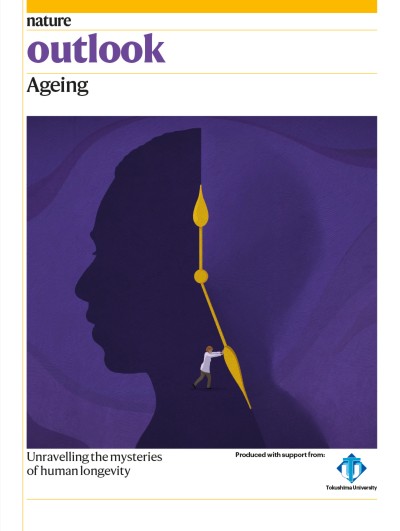
Jeanne Calment became the world’s oldest person before she died in 1997 at the age of 122.Credit: Jean-Paul Pelisser/Reuters/Alamy
In the late eighteenth century, while in hiding from his fellow French revolutionaries, the philosopher and mathematician Nicolas de Condorcet posed a question that continues to occupy scientists to this day. “No doubt man will not become immortal,” he wrote in Sketch for a Historical Picture of the Progress of the Human Mind, “but cannot the span constantly increase between the moment he begins to live and the time when naturally, without illness or accident, he finds life a burden?”
The answer to that question remains the subject of debate. Some researchers posit that modern human lifespans are nearing a natural ceiling, whereas others see no evidence for such a limit. Arguments have often become heated, with research articles occasionally prompting angry letters to journal editors and even allegations of fraud.
Part of Nature Outlook: Ageing
“People have drawn a line in the sand with their particular vision of what old age is like,” says Steven Austad, a gerontologist at the University of Alabama at Birmingham. “And now they’re refusing to cross that line, irrespective of what the accumulated evidence suggests.”
Jean-Marie Robine, a demographer at INSERM, France’s national biomedical research institute in Paris, points out that the limits of lifespan sparked curiosity long before Condorcet. “It is possibly the oldest research question we have,” he says. Even if no formal physiological limit exists, reaching the frontiers of survival is no mean feat, and further gains in longevity might ultimately require remarkable advances in medical science, even if the ranks of the world’s centenarians continue to swell.
Plateau, or no?
One of the first efforts to map the boundaries of human lifespan came from the British mathematician and actuary Benjamin Gompertz in 1825. His analysis of demogra-phic records demonstrated that after a person’s late twenties, their risk of dying increased at an exponential rate year after year — sugesting that there is a horizon where that risk finally reaches 100%.
“Gompertz speculated that this was a law equivalent to Newton’s law of gravity,” says Jay Olshansky, an epidemiologist and gerontologist at the University of Illinois Chicago. Almost 200 years later, Gompertz’s work remains influential. His model still seems to accurately map the pattern of age-related mortality for a sizeable portion of the human lifespan, even though medical advances have shifted the timing somewhat.
In 1996, for example, a mathematical analysis1 by Caleb Finch and Malcolm Pike at the University of Southern California in Los Angeles used the Gompertz model to estimate a maximum human lifespan of around 120 years — a reasonable ceiling, given that only one person had reached that age.
However, the authors also speculated that medical advances in controlling senescence and treating chronic disease could theoretically bend the curve and make that limit a routine life expectancy in the future.
Questions have emerged about the flexibility of Gompertz’s model as more and more people reach ages that were considered exceptional a few generations ago. The United Nations estimates that there were 573,000 centenarians alive worldwide in 2020 — more than 20 times the number 50 years earlier. And hundreds of people reached the rarefied ranks of the supercentenarians — aged 110 or older — although demographers have validated the records of only a fraction of them. The current longevity record is held by Jeanne Calment, a French woman who passed away in 1997 at the age of 122 years and five months (see ‘The rising age of the longest-living human’).
The rising age of the longest-living human
Name | Born | Died | Age | Where |
|---|---|---|---|---|
Geert Boomgaard | 1788 | 1899 | 110 years, 135 days | Groningen, Netherlands |
Margaret Ann Neve | 1792 | 1903 | 110 years, 321 days | Guernsey, Channel Islands |
Louisa Thiers | 1814 | 1926 | 111 years, 138 days | Milwaukee, Wisconsin |
Delina Filkins | 1815 | 1928 | 113 years, 214 days | Richfield Springs, New York |
Fannie Thomas | 1867 | 1981 | 113 years, 283 days | Los Angeles, California |
Anna Eliza Williams | 1873 | 1987 | 114 years, 208 days | Swansea, UK |
Jeanne Calment | 1875 | 1997 | 122 years, 164 days | Arles, France |
These trends have fuelled debate about just how far we can go. A 2016 study2 by geneticist Jan Vijg’s group at the Albert Einstein College of Medicine in New York City analysed the maximum reported ages of death in France, Japan, the United States and the United Kingdom, and concluded that survival past the age of 125 is exceedingly unlikely. This proposal of a de facto maximum lifespan proved controversial, drawing numerous published responses that questioned both the statistical methods used and the interpretation of the results.
Two years later, a group led by demographer Elisabetta Barbi at the Sapienza University of Rome challenged Vijg’s findings with a study of Italians over the age of 105. The team’s data indicated that the Gompertz curve actually plateaus at this extreme age3, with mortality risk levelling off to a 50% chance of survival every subsequent year — thus reaching no firm longevity limit. But these findings also became a subject of strong contention.
One of the biggest challenges when studying supercentenarians pertains to poor — or even deceptive — record-keeping. “There are so many misreports,” says James Vaupel, a biodemographer at the University of Southern Denmark in Odense who co-authored Barbi’s study. Some of these are clerical errors or the product of confused reports by extremely elderly individuals with memory problems, he says, but some seem to be instances of fraud by families bidding for fame.
Regardless of the cause, the effect on the data is ultimately the same, says Leonid Gavrilov, a biodemographer who studies human longevity at NORC at the University of Chicago, Illinois. Such errors generally bias the demographic data in a way that suggests a misleadingly reduced risk of mortality at extreme old age, he adds.
Any attempt to survey supercentenarians therefore requires considerable detective work to verify their age. “You have to basically trace the person over their whole life,” says Vaupel.
Vaupel points out that Barbi’s analysis used rigorously vetted data derived from the International Database on Longevity (IDL). The IDL was developed by a network of gerontologists and demographers, including Vaupel and Robine, and relies on careful review of birth certificates, baptism records, census details and other sources of information to validate each supercentenarian’s claim. Nevertheless, Robine says that “we could still spend a few years more working on the quality of the data” available for supercentenarians.
Indeed, a 2020 study4 from Gavrilov and his wife and fellow biodemographer Natalia Gavrilova has questioned the utility of even the IDL for making predictions about population-scale longevity trends. Gavrilov thinks that another validated supercentenarian data set maintained by the Gerontology Research Group — a Los Angeles-based network of gerontology researchers — is a better tool for this purpose. Using this data set, he and Gavrilova observed continued sharp growth in the mortality rate beyond the age of 113.
Critics also contend that models of survival at extreme ages run into the inevitable problem of sharply dwindling numbers. “The plateau is a result of having too few people to generate reliable mortality statistics,” says Olshansky. This might result in misleading or inaccurate trends that disappear as more data become available. Indeed, this happened with Gompertz’s original model, which lost its predictive power beyond the age of 85, which was extremely old in the nineteenth century.
But Vaupel stands by his findings. “The numbers are serviceable up until age 114,” he says. “And if there’s a plateau from 105 to 114, there’s no reason why that plateau should not continue.”
To oldly go
Calment’s record survival of 122 years and five months is not only unbroken, but also unrivalled — the nearest contender was Sarah Knauss, who passed away at the age of 119 in 1999. The existence of such an extreme outlier has also been a cause of contention. In 2019, Nikolay Zak, a Moscow-based mathematician and economist, claimed that Calment had in fact died decades earlier, and that her identity had been assumed by her then-elderly daughter. “It was a paper attacking my work,” says Robine, who is among the researchers who knew Calment and validated her longevity.
The scientific consensus supports Calment’s claim. Vaupel notes that the field of ‘extreme value theory’ mathematics — which assesses the probabilities associated with ultra-rare or even unprecedented events — has shown that such records often go unbroken for many years. In a 2019 paper5, he and his colleague Anthony Medford estimated that there was a 20% chance that Calment’s achievement might remain unsurpassed by 2050.
The rarity of survival to such advanced ages underlines a greater statistical truth, which holds regardless of whether or not mortality reaches a plateau. “The most optimistic thing you can say is that after age 105, your chance of dying stops going up,” says Brandon Milholland, a data scientist at healthcare data company IQVIA in New York City and co-author on the Vijg lab’s 2016 paper.
If the plateau is real, the number of living 110-year-olds required to produce a survivor beyond that age would roughly double for each successive year of longevity. “This means the odds of anybody getting to be more than about 120 or 125 are vanishingly small,” says Austad. “It’s not really the limit that people who talk about limits think about, but it’s also not immortality.” And if the plateau is merely an artefact, as some contend, the odds shrink even more.

Kane Tanaka became the world’s oldest living person in 2018. She was born on 2 January 1903.Credit: The Asahi Shimbun/Getty
Progress in extending average life expectancy could potentially increase the odds of individuals reaching an extreme old age by creating ever-larger numbers of centenarians. Major advances in preventing infant and child mortality, and in the treatment of chronic and infectious diseases, have already produced considerable improvement in this metric.
In a 2002 publication6, Vaupel noted that life expectancies in Sweden and Japan had increased by as much as three months per year since 1840. Indeed, Japanese women currently have the highest average life expectancy in the world, at 87 years. It remains an open question whether such gains will continue — there has been little improvement in life expectancy in the United States or United Kingdom over the past decade.
But Shripad Tuljapurkar, a biodemographer at Stanford University in California, says that much of this stagnation might be due to the rise in premature mortality from drug and alcohol abuse, suicide and other ‘deaths of despair’. In 2018, he and his colleagues showed evidence7 of a steady improvement in life expectancy for individuals in their 60s in the United States, Japan and Sweden. “From my perspective, the main takeaway is that we are simply able to keep people living longer,” he says. “And I don’t see a slow-down.”
Low- and middle-income countries are at a disadvantage in terms of life expectancy relative to their wealthy peers, but they also have opportunities for major gains. Indeed, World Bank estimates have shown a steady increase to an average life expectancy of 71 years in 2019 — an improvement of six years on the figure two decades earlier.
Robine also thinks that life expectancy is increasing. In a 2021 paper8 published by the UN, he analysed French demographic data to monitor the highest age reached by at least 30 individuals who died in a given year, eliminating the confounding effects of rare outliers such as Calment on population-scale longevity. Remarkably, this metric had steadily increased from 99 years in 1946 to 109 years in 2016. “It was just a straight line,” says Robine.
But he points out there is robust evidence that we might be experiencing a phenomenon known as compression of mortality, in which populations are generally surviving to older ages without meaningfully pushing the outer limits of longevity. Gavrilov sees a similar pattern. “You have much better survival to age 100,” he says, “but the remaining life expectancy at age 100 is the same, with no documented progress in the last 80 years.” In other words, the exceptionally elderly are still at the mercy of nature’s coin toss.
System failure
One of the fundamental rifts in this debate is between demographers and life scientists. “When you get mathematical demographers failing to consider the biological forces that influence the statistics they’re looking at, it leads to unrealistic estimates of the future of life expectancy,” says Olshansky.
Milholland points out that gerontologists have identified nine cellular and molecular features that are strongly associated with ageing and mortality9. These range from shortening of the telomeric structures that cap the chromosomes and prevent genetic damage, to the accumulation of defective proteins and toxic metabolites and the loss of regenerative stem cells. Milholland sees these breakdowns in the cellular machinery as natural and inevitable outcomes of running a complicated biological machine for many years on end.
“Why would these processes suddenly halt at age 110?” he asks. Supercentenarians may have some genetic features that enable them to mitigate some of these processes — and numerous genomic studies are now under way to investigate this — but there may simply be too many breakdowns to live beyond a certain age.
Some studies have suggested that interventions that tweak metabolic activity or alterations to the diet can confer significant longevity gains in species such as flies, worms and even mice. But Olshansky cautions that the effects of interventions to delay ageing are likely to be skewed in these animal models. “The problem is that the longer a species lives in general, the less longevity benefit there is to be expected from any sort of intervention,” he says. So a treatment that allows a worm to live a few months, rather than a few weeks, cannot be expected to likewise propel humans into multiple centuries of survival. “We’re living life on different timescales,” he adds.
Even if breakthroughs in treating disease in children and adults have paved the way to considerably longer life expectancy, Austad doubts that similar progress with age-related diseases will have much effect. A condition such as Alzheimer’s disease accounts for only a small fraction of all deaths, he says, and even stopping diseases with higher rates of mortality, such as cancer, will not extend lifespan very far. “If you cure that, it adds two years to life expectancy, and probably not that much at the very extremes,” he explains.
Such pessimism might seem surprising, given that Austad famously made a bet in 2000 with Olshansky that the world’s first 150-year-old had already been born. But this wager was predicated on the expectation that biomedical technology would, in that timeframe, achieve a more far-reaching victory in terms of delaying the ageing process itself.
Whether such progress is forthcoming is unclear, but there is broad agreement that medical interventions that bend the mortality trajectory could be a game-changer, even if they never deliver Condorcet’s vision of near-immortality. “I think a limit exists,” says Milholland. “But it’s not an unchangeable limit.”


 Ageing
Ageing
 How the COVID-19 pandemic might age us
How the COVID-19 pandemic might age us
 Robots rise to meet the challenge of caring for old people
Robots rise to meet the challenge of caring for old people
 Support for LGBTQ+ people in later life
Support for LGBTQ+ people in later life
 Tackling the crisis of care for older people: lessons from India and Japan
Tackling the crisis of care for older people: lessons from India and Japan
 The biological clean-ups that could combat age-related disease
The biological clean-ups that could combat age-related disease
 Research round-up: Ageing
Research round-up: Ageing
 Turning back time with epigenetic clocks
Turning back time with epigenetic clocks





